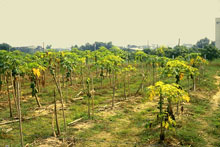
Fig. 1. Papaya orchard severely infected by PRSV in Taiwan. PRSV is the most destructive virus of papaya worldwide. |
|
Papaya is a tropical fruit crop that is normally consumed fresh and is valued as a health food because it's rich in vitamins C and A. In Hawaii, small high quality papayas, called the Hawaiian solo type, are grown commercially for export to the mainland United States and Japan. It is the state's second largest fruit crop. However, papaya is severely damaged when infected by the papaya ringspot potyvirus (PRSV), which is rapidly transmitted by a number of aphid species. In fact, PRSV causes the most serious virus disease of papaya worldwide.
The PRSV threat in Hawaii
PRSV was discovered in Hawaii in the 1940s and virtually eliminated large papaya production on Oahu island in the 1950s, causing the papaya industry to relocate to Puna district on Hawaii island in the early 1960s (Fig. 2). The papaya industry thrived in Puna because of ideal rainfall conditions, availability of land, and most importantly, because Puna was free of PRSV. Even though PRSV was only 19 miles away from Puna, geographic isolation and diligent surveillance and rouging efforts had kept the virus from Puna and, consequently, 95% of Hawaii's papaya was being produced in Puna by the 1980s.
|
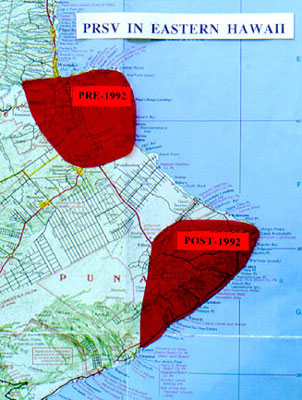
Fig. 2. Map of Hawaii island which shows the papaya industry in the Puna district, the area where PRSV was prior to May 1992, and the subsequent PRSV invasion into the Puna district.
|
|
A papaya transformation system
Despite this apparent freedom of PRSV in Puna, it was reasonable to assume that Puna would eventually become infected with the virus (Fig. 3). Thus, in the late 1980s we started a research project to develop transgenic papaya by using the new concept of 'pathogen-derived resistance', where it was proposed that transforming plants with a pathogen's gene would result in the transgenic plant being resistant (Fig. 4). In other words, a gene from the pathogen was being used to fight against the pathogen itself. Work progressed rapidly, primarily because the team (Gonsalves, Slightom, Manshardt, and Fitch) had a focused approach and had the right blend of expertise. Additionally, we had the good fortune to work with Dr. John Sanford at Cornell University, Geneva, New York who had recently invented the gene gun, a device that can literally "shoot" genetic information obtained from one kind of organism into cells of another. A papaya transformation system was developed whereby young embryos from papaya seeds of the commercial Hawaiian solo cultivar 'Sunset' were transformed with the coat protein gene of a PRSV isolate from Hawaii and a promising transgenic papaya line (55-1) that showed resistance to PRSV from Hawaii was identified in 1991.
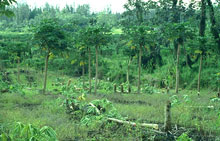 |
|
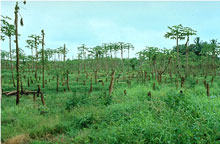 |
| Fig. 3. Papaya was discovered in Puna in May 1992. (Left) Infected trees were cut in attempts to control spread of virus. Picture taken in May 1992. (Right) By late 1994, PRSV had spread throughout the Puna district and was out of control. Many orchards were abandoned because of severe virus infection. Picture taken in February 1995. |
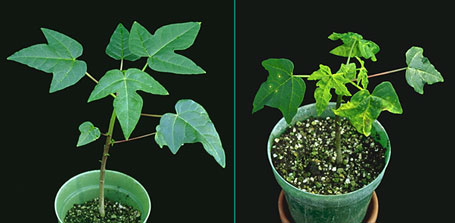
Fig. 4. Transgenic papaya inoculated with PRSV from Hawaii (left) and nontransgenic papaya inoculated with PRSV from Hawaii (right). Note the resistance of transgenic papaya. |
A transgenic line shows promise
Two critical things happened in 1992. A small scale field trial of line 55-1 was initiated on Oahu island in April and the long awaited invasion of PRSV into the Puna district was observed in May. By December 1992, the results from the Oahu island field trial showed that line 55-1 was highly resistant to PRSV (Fig. 5). While all control plants became infected in 77 days, R0 clones of line 55-1 remained resistant to PRSV.
Fruit quality and plant growth characteristics of line 55-1 were similar as 'Sunset' which gave us confidence that line 55-1 could be used commercially. In contrast to the good results of the transgenic papaya, PRSV spread very rapidly in Puna and by late 1994, nearly half of Puna's papaya acreage was infected and a number of farmers were going out of business.
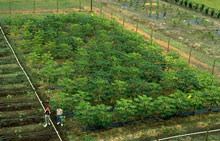 |
|
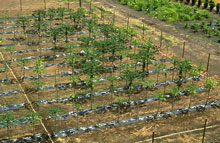 |
| Fig. 5. Field trial of RO plants of line 55-1; trial established in April 1992. (Left) Picture taken in December 1992. Border trees are nontransgenic papaya mechanically inoculated with PRSV. Trees within the border are mixture of transgenic and nontransgenic papaya. Trees with yellow canopy are nontransgenic infected with PRSV while those with the green canopy are trees of transgenic line 55-1. (Right) Picture taken in June 1993. Note that all of nontransgenic plants are severely infected with PRSV while plants of transgenic line 55-1 remained uninfected and still have green canopies. |
Field evaluations of transgenic papaya
In 1994, Dr. Steve Ferreira joined the team and directed the establishment of a large scale field trial of transgenic papaya near an abandoned papaya orchard in Puna, following guidelines spelled out in a permit from the Animal Plant Health Inspection Service (APHIS). The field trial consisted of the newly named 'UH SunUp', which is line 55-1 that is homozygous for the coat protein gene, and 'UH Rainbow', which is a hybrid resulting from a cross of 'UH SunUp' and nontransgenic 'Kapoho', the dominant papaya cultivar grown in Hawaii. Like the first field trial, results were dramatic. All nontransgenic plants became infected 11 months after transplanting while all but three of the transgenic plants have remained resistant to PRSV even 35 months after initiating the trial. Fruit quality of 'UH SunUp' and 'UH Rainbow' were good and farmers voiced approval of these transgenic papaya.
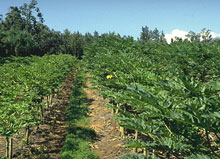 |
|
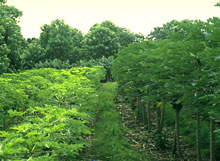 |
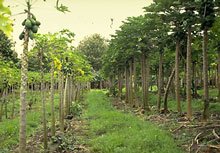 |
| Fig. 6. Field trial of transgenic 'UH Rainbow' and 'UH SunUp' was established in Puna in October 1995. Slides show the progress of the disease caused by PRSV in rows of nontransgenic papaya (left in each picure) as compared to the resistance in rows of 'UH Rainbow' (right in each picture). (Top left) Picture taken in June 1996. (Top right) Picture taken in November 1996. (Bottom) Picture taken in March 1997. These pictures show the excellent resistance of the transgenic papaya to PRSV. |
Approval for commercialization of transgenics
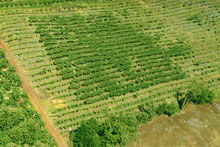
Fig. 7. Aerial view of transgenic field trial in Puna that was started in October 1995. The solid block of green papaya trees are 'UH-Rainbow' while the surrounding papaya trees that are nearly dead are nontransgenic papaya trees severely infected by PRSV. Picture taken in May 1997.
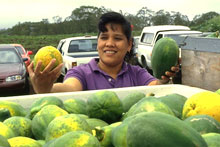
Fig. 8. Woman holding transgenic 'UH Rainbow' that will be graded in a commercial packinghouse. Fruit are from the transgenic field trial in Puna.
|
|
However, could line 55-1 be deregulated and commercialized in time to help the papaya growers? Efforts to deregulate the papaya through APHIS and the Environmental Protection Agency (EPA) , and to hold consultations with the Food and Drug Administration (FDA) were initiated in 1995. By September 1997, these processes had been completed, with excellent cooperation from these agencies.
The other phase of commercialization, obtaining licenses from owners of intellectual property rights which were used to develop the transgenic papaya, was undertaken in 1995 by the Papaya Administrative Committee (PAC), a USDA marketing order group consisting of many of Hawaii papaya growers. Due to the severity of the PRSV problem in Hawaii, PAC funded a program to produce seeds of 'UH SunUp' and 'UH Rainbow' so that these would be available near the time that the papaya was commercialized. All license agreements were completed by April 1998 and distributions of transgenic papaya seeds to Hawaii papaya growers were started in May 1998.
The future of transgenic papaya
The impact of the transgenic papaya on reclaiming the papaya growing area in Puna will be known in the next several years. We are hopeful that Hawaii papaya growers will find good fortune at the end of the 'Rainbow.'
